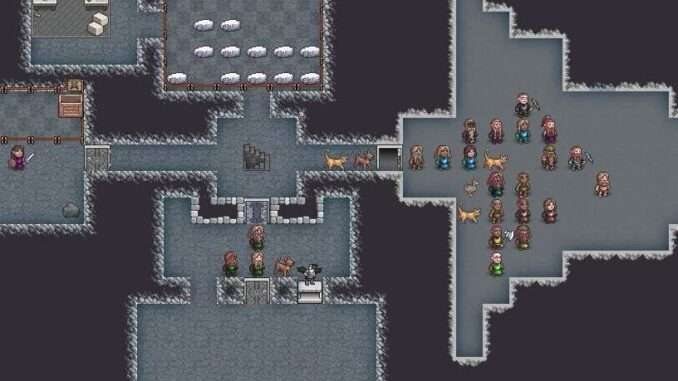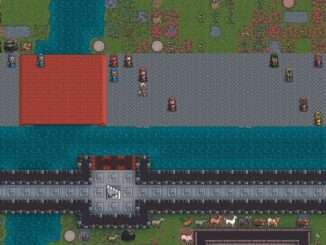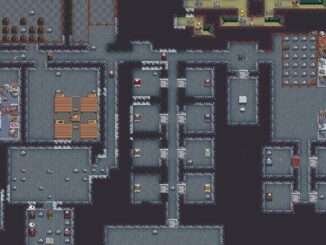
Beginners Tips and Tricks
Note: Credit goes to The Trashman
1) Config changes
The default population cap of 200 can be a lot to learn with. Lowering it to, say, 40, can help keep a first fort more manageable. In addition, turning migrant labours to ‘off’ means new migrants will arrive with all non-skilled labours disabled. This makes dealing with migrant waves a little easier and stops some novice kicking your legendary weaponsmith out of the forge, or fisherdwarves flooding you with hundreds of fish.
To make these changes, open the file {path_to_dwarf_fortress_folder}/data/init/d_init.txt and change:
- [POPULATION_CAP:200] -> [POPULATION_CAP:40]
- [SET_LABOUR_LISTS:SKILLS] -> [SET_LABOUR_LISTS:NO]
2) Checking the units list
The ‘u’ screen has a tab (Others) for showing creatures on the map that don’t belong to your fort. Checking this intermittently can help identify if something dangerous wanders onto the map, especially if you’ve breached the caverns. From this menu, you can select the creature and hit ‘v’ to get more info about it, or ‘z’ to zoom to where it is on the map.
3) Labours
If nothing is getting done, check the ‘u’ screen and see what your dwarves are doing. If they’re storing things in stockpiles instead of more important tasks, cancel hauling and other labours on relevant dwarves (select the dwarf from the ‘u’nits menu and hit ‘z’ to zoom to them, then ‘p’ for preferences and ‘l’ for labour. Pressing shift-enter will enable/disable all sub-labours. You can also hit ‘v’ from the main screen and move the cursor to a dwarf instead of ‘u’->’z’). I usually cancel hauling on at least my carpenter, mason and miner.
4) Shift it
The shift key can be used in a few places to speed things up. When you’re moving a cursor around (like when looking, building furniture or designating mining) holding shift and pressing a direction will move the cursor 10 tiles in that direction. When you’re building something that requires choosing many materials (like when building a 5×5 floor) clicking shift+enter on a material will use the max available of that material.
5) The manager noble and work orders
Work orders are a great way of automating work, especially in larger forts. Once you’ve assigned a manager from the nobles screen (accessible by pressing ‘n’), you can create conditional jobs on workshops. For example, once I’ve built a still, I appoint a manager and create a work order for brewing drinks 5 times whenever we have less that 50 drinks. All I have to do then to keep the booze flowing is ensure a supply of brewable plants and barrels/pots, and I’ll get warnings if we run out of either. The manager also opens more options for workshops, like setting max/min skill levels.
6) Strange moods
Sometimes dwarves get strange moods, and create something special. To do this, they’ll claim a workshop and gather resources from around your fort. If they need a material that isn’t present, they will be unable to start their project and will eventually have a breakdown that will result in their death. When a dwarf gets a mood, you can use the ‘q’ key to look at the workshop they claim. If required materials are missing, the workshop’s ‘q’ screen will tell you what the dwarf needs. Common missing items are shells (which can be acquired from processing certain fish in the fishery), and distinct types of cloth (moody dwarves distinguish between silk, plant and yarn cloth). The wiki has a lot of info on strange moods.
7) Starving animals
Non-grazing animals don’t need to be fed. Grazing animals do, however. Left alone, they will go hang out in your grass-less dining hall and slowly starve to death. Putting grazing animals in a pen/pasture where there’s grass (‘i’ for zones, mark out the zone over some grass or cave moss, ‘n’ to designate it as a pen, ‘N’ to set pen/pasture information, then use ‘+’ ‘-‘ ‘Enter’ to assign grazing animals) will stop them starving to death.
8) Pay attention to the starting area
The surroundings of your starting location can make a huge difference in game difficulty. Evil areas (Sinister, Haunted, Terrifying, names displayed in purple) have a lot of nasty features that make the game MUCH harder. Good areas (Serene, Mirthful, Joyous Wilds, names displayed in a light blue) can have surprisingly dangerous wildlife. Neutral surroundings (Calm, Wilderness (both names displayed as green), Untamed Wilds, name displayed in yellow) are much safer. Calm and Wilderness are the safest, though, as ‘savage’ surroundings (Untamed Wilds) can have giant versions of wildlife which can pose a threat to civilians.
In terms of checklist for easiest starting location, I’d say critically:
- Trees
- Surroundings: Calm or Wilderness
- No Aquifer
- Under the neighbours tab, no at-war neighbours, no tower
- At least some soil
- Water source (river, stream or brook)
And less critically (nice to have but not necessary):
- Flux stone
- Shallow metals
- Deep metals
Not sure whether people would agree with those or add extra.
9) Keep a small stockpile of bricks…
Keep a small stockpile of bricks (rock blocks) near major hallways, especially the entrances to the surface & underground. If a visitor shows up that you aren’t ready to deal with, you can quickly build a wall to keep it out.





Be the first to comment